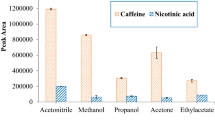Abstract
Capillary electrophoresis with amperometric detection (CE-AD) has been used for the determination of catechin, rutin, ferulic acid, o-dihydroxybenzene, chlorogenic acid, caffeic acid, gallic acid, and protocatechuic acid in coffee. Comparison of extraction efficiency of antioxidants using different polar solvents was also conducted by this method. Effects of several important factors including the acidity and concentration of running buffer, separation voltage, and working electrode potential, were evaluated to obtain the optimum analysis conditions. The working electrode was a 300 um carbon disc electrode at an applied potential of +0.95 V (vs. saturated calomel reference electrode). Under the optimum conditions, the analytes can be well separated within 26 min in a 75 cm length fused-silica capillary (i.d. 2.5 × 10−5 m). The current response was linear over three orders of magnitude with detection limits (S/N = 3) ranging from 6.0 × 10−8 to 3.6 × 10−7 g/mL for all analytes.





Similar content being viewed by others
References
Shahidi F, Zhong Y (2007) ACS Symp Ser 956 (Antioxidant Measurement and Applications):36–66
Zhou B, Liu ZL (2005) Pure Appl Chem 77(11):1887–1903
Blomhoff R (2005) Curr Opin Lipidol 16(1):47–54
Scalbert A, Manach C, Morand C, Remesy C, Jimenez L (2005) Crit Rev Food Sci Nutr 45(4):287–306
Shahidi F (2000) Nahrung 44(3):158–163
Zheng DY, An XN (2004) Chem Ind For Prod 24(3):113–118
Ye Y, Feng CH (2000) China Food Addit 1:42–45
Zhu M, Wang FQ (2004) Sci Tech Food Ind 25(9):74–78
Clifford MN, Ohiokpehai O, De Menezes H (1985) The influence of extraction and analytical method on the chlorogenic content of green coffee beans [A]. Proceedings of the 11th International Scientific Colloquium on Coffee [C]. ASIC, Paris, pp 252–262
Clifford MN, Williams T, Bridson T (1989) Phytochem 28:829–838
Olthof MR, Hollman PC, Buijsman MN, van Amelsvoort JM, Katan MB (2003) J Nutr 133(6):1806–1814
Chinese Traditional, Herb Drug Information Center State Medicine and Drug Administration (1986) Handbook of herb drug active ingredient. People’s Medical Press, Beijing, pp 209–210
Rice-Evans CA, Miller NJ, Paganga G (1996) Structure and antioxidant activity relationships of flavonoids and phenolic acids. Free Radic Biol Med 20(7):933–956
Wang SP, Huang KJ (2004) J Chromatogr A 1032(1–2):273–279
Mattila P, Kumpulainen J (2002) J Agric Food Chem 50(13):3660–3667
Ramirez-Martinez JR (1988) J Sci Food Agric 43(2):135–144
Casal S, Andrade PB, Oliveira MB, Ferreres F, Garcia-Viguera C, Ferreira MA (1999) J Liq Chromatogr Relat Techol 22(4):513–521
Dogasaki C, Shindo T, Furuhata K, Fukuyama M (2002) Yakugaku Zasshi 122(7):487–494
Arts ICW, van de Putte B, Hollman PCH (2000) J Agric Food Chem 48(5):1752–1757
Galli Va, Barbas C (2004) J Chromatogr A 1032(1–2):299–304
Hu Q, Zhou TS, Zhang L, Fang YZ (2001) Analyst 126(3):298–301
Cai RL, Han YS, Zhao JF, Liu HK (2003) Beverage Ind 6(6):32–37
Chu QC, Lin M, Tian XH, Ye JN (2006) J Chromatogr A 1116(1–2):286–290
Chu QC, Fu L, Guan YQ, Ye JN (2005) J Sep Sci 28:234–238
Chu QC, Fu L, Guan YQ, Ye JN (2005) J Agric Food Chem 52:7828–7833
Fang YY, Fang XM, Ye JN (1995) Chem J Chin Univ 16(10):1514–1518
Ye JN, Baldwin RP (1993) Anal Chem 65(23):3525–3527
Hoffstetter-Kuhn S, Paulus A, Gassmann E, Widmer HM (1991) Anal Chem 63:1541–1546
Acknowledgments
The authors are grateful for the financial support provided by the National Science Foundation of China (grant No. 06DZ05125).
Author information
Authors and Affiliations
Corresponding author
Rights and permissions
About this article
Cite this article
Chu, Q., Lin, M., Yu, X. et al. Study on extraction efficiency of natural antioxidant in coffee by capillary electrophoresis with amperometric detection. Eur Food Res Technol 226, 1373–1378 (2008). https://doi.org/10.1007/s00217-007-0667-z
Received:
Accepted:
Published:
Issue Date:
DOI: https://doi.org/10.1007/s00217-007-0667-z




